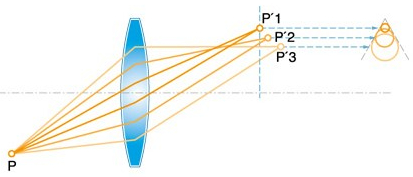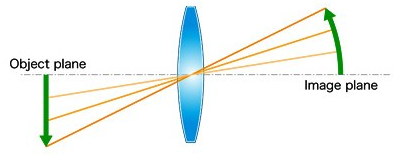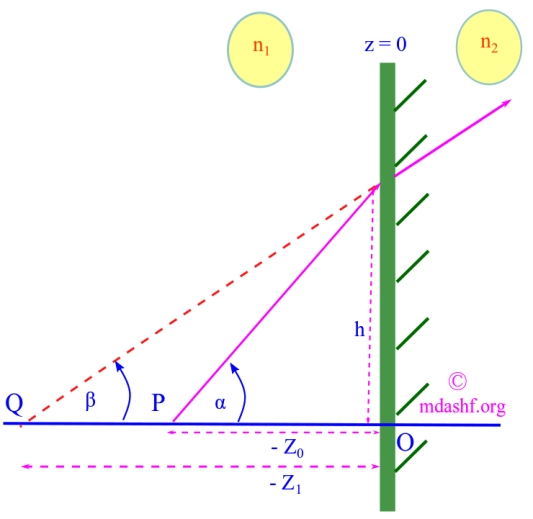Optics series, lecture — II
This lecture was delivered on 27 – 1 – 2017
( all optics series lectures ) go to other available optics lectures
In our last lecture in this series we discussed the phenomena of aberrations that arise because of a discrepancy of the first order theory and the third order theory as depicted by the Maclaurin series, where we saw that first order theory represents the so called paraxial optical systems.
( Lecture — I: “Optical Aberrations” ) click to read the lecture on optical aberration
You might want to have a look at lecture — I, linked above, to get a basic view of the ground on which we are discussing this topic. At-least going half-way through the lecture and stopping short of the derivation will do well.

“Primary aberration”
We discussed that there are two kind of aberrations. a. monochromatic and b. chromatic.
- Monochromatic aberration
- As the name suggests the monochromatic aberrations are a result of the discrepancy when we considered our incoming ray to be having a single wavelength of light.
- Chromatic aberration
- The chromatic rays on the other hand can have multiple colors or wavelength of light. The monochromatic aberrations are also called as Seidel or primary aberrations and we will shed more light on them today.
The chromatic aberrations were dealt in greater detail — eg the derivations pertained to the chromatic aberrations. We did so because the chromatic aberrations are simple to understand.
We also hinted about the general nature of the primary aberrations ( also known by the name Seidel or monochromatic aberrations ). In this lecture we will learn about them in greater detail. Here is what we are aware of already from the lecture on aberrations.
- a. Spherical aberration
- This occurs due to different location of the ray wrt optical axis, producing multiple focuses and as a result blurring the image. The object has to be axial ( on optical axis i.e. ) but the rays could be both axial or off-axis. The off-axis rays in case of axial objects produce larger spherical aberration
- b. Coma
- Its a comet like image production when objects are no more on the optic axis but ‘slightly’ off-axis
- c. Astigmatism
- It refers to a kind of aberration caused when objects points are ‘considerably’ off-axis
- d. Petzval field curvature
- When objects points are ‘considerably’ off-axis the focal points are on two different surfaces causing astigmatism, when the focal points coincide astigmatism is zero but there still is some curvature on the image surface, this is referred to as curvature of field
- e. Distortion
- It is caused due to non-uniform magnification
The first three type of aberrations lead to a deterioration in the quality of the image making them unclear. The last two types cause deforming of the shape or size of the images.
The primary aberrations can be minimized by manipulating the various physical attributes of the optical system, such as; power, shape, thickness, material and separation of lenses.
So lets discuss in detail these 5 types of primary aberrations now.
Primary aberration
1. Spherical Aberration
When paraxial rays refract after emerging from an object point they meet at a sharp focus. But when non-paraxial or marginal rays emerge — or appear to emerge, from an axial object point they do not meet at a sharp focus. Therefore different rays meet at different focal points. The resulting aberration is called as spherical aberration.


For a refraction from spherical surface lets apply the Fermat’s principle. The principle states that optical path length is stationary wrt any change in the position coordinates, of the ray. Time and again we will be applying the Fermat’s principle, which is the backbone of geometrical or ray optics. We have discussed this in detail in our next lecture in the series.
The following two articles were written in a style different from lecturing styles meant for honors students. But I hope they shed a good deal of conceptual light on the meaning of Fermat’s principle. You might wanna have a look at them.
( Article – 1; “Optical path and Fermat’s principle” ) a casual discussion of Fermat’s principle
The Fermat’s principle applied for a refracting spherical surface would give, in the first order, the following:
If we apply 3-rd order corrections as-well we would get the following:
Here h is the height at which the incident ray is refracted at the spherical surface.
We see that h is larger for marginal or peripheral rays hence SA ( henceforth for spherical aberration ) is larger for marginal rays compared to rays near optical axis ( known as paraxial ray ) and grows as rapidly as the square of the height of ray, SA is proportional to square of h.
Photo-Credit:

The distance between axial intersection of a ray and paraxial focus Fp is known as longitudinal spherical aberration. It is abbreviated as L.SA or Slong.
L.SA is positive for converging or convex lens. Convex lenses are considered positive lenses. Similarly L.SA is negative for diverging or concave lens. Concave lenses are considered negative lenses.
The image blur is smallest on circle of least confusion.
The height from the paraxial focus where a marginal ray meets is called as transverse spherical aberration or T.SA.
Lets discuss some of the important results of spherical aberration without having to go through the strenuous exercise of deriving them by fundamental principles.
a. For a plane refracting surface.
Spherical aberration due to refraction at plane surface is given by the following expression:

b. For a single spherical refracting surface the corresponding expression is given by:
c. For a thin lens in air we define coefficient of spherical aberration by A. Then the following expressions are obtained.
where .
Then we would have
and
.
Note: The only primary aberration that occurs when object points are axial is spherical aberration. All other primary aberrations are absent for axial object points.
2. Coma
We learned that for object points that are axial, only one type of primary aberration occur, namely the spherical aberration. What would happen if we move slightly off the optical axis? Both coma and SA would occur. Coma is a comet like image — hence the name, of a slightly off-axis object point.


If a parallel bundle of rays making an angle θ with the optical axis are incident on a thin lens then expression for coma is given by:
For a lens of shape factor q = + 0.8 coma is zero, where: .
If Abbe sine condition is satisfied both SA and coma are zero:
For Plano-convex lens when light is incident on the convex side, q = 1, and SA and coma are minimum. Coma is more prominent when object point is off axis and rays are obliquely incident.
3. Astigmatism
When the object point is considerably off-axis the incident rays of light strike the lens asymmetrically. There are two important planes defined for an optical system, which are mutually perpendicular. These two planes are called as meridional — or tangential, and sagittal plane.
Due to asymmetry of incidence of rays in these two planes the focal lengths corresponding to these planes differ. This gives rise to astigmatism.
Astigmatism comes from Greek: for a = not and stigma = point or spot. Similarly sagitta is Latin for arrow.
Remember that the meridional plane contains the principal ray and optical axis. The sagitta plane is perpendicular to the meridional plane.

4. Curvature of field
We saw that astigmatism occurs when sagittal and meridional planes have an asymmetric amount of incidence. This happens when object-point is highly off-axis and the resultant focal lengths of the two planes differ.
On the sagittal plane there is a line of focus perpendicular to the meridional plane and is called as sagittal focal-line. Similarly on meridional plane there is a focal line perpendicular to the sagittal plane and its called as meridional focal-line.

So the focal points lie on two different surfaces. When they coincide astigmatism is zero. But even then resulting image surface is curved. This is known as curvature of field.
5. Distortion
Like SA, distortion can be an exclusive aberration. All other primary aberrations can be absent even when distortion is the only primary aberration that is present in a system. Distortion is caused due to non-uniform magnification.





Leave a comment